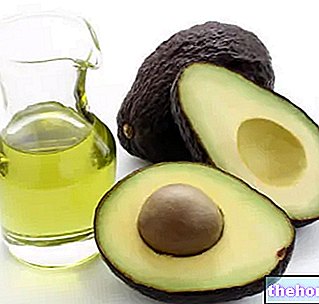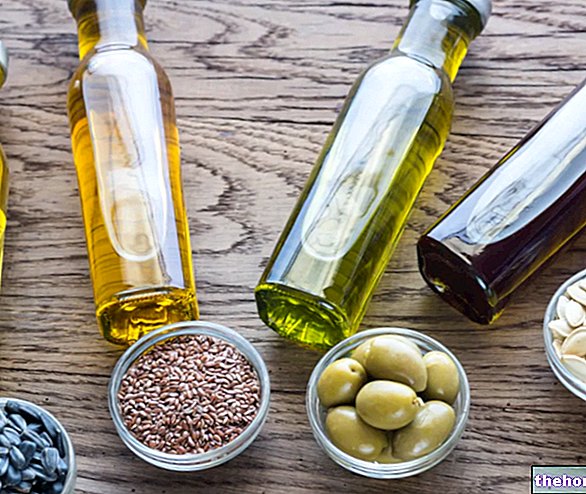The most common seed oils
Seed oils are oils obtained from fruits or from seeds of plants and trees other than olive. These products are used first of all in the food field, but also find applications in the cosmetic one (wheat germ oil, avocado .. .), in the chemical industry (especially in the paint industry), and in the pharmaceutical industry (for example as a vehicle for some drugs, in the preparation of infusions for parenteral nutrition, etc.)
In-depth articles:
In addition to the olive tree, many other plant species have seeds (70%) or fruits (30%) with an oil content such as to make their extraction convenient. Let's see the main ones;
PLANT
PART USED
PRODUCTS
Sunflower
Whole seed
Edible oil, margarine
Peanut
Whole seed
Edible oil, margarine
Safflower
Whole seed
Edible oil, margarine
Soy
Whole seed
Edible oil, margarine, baked goods
Rapeseed
Whole seed
Edible oil, margarine
Coconut
Fruit
Margarine, baked goods, cosmetics
Palm tree
Fruit (pulp)
Margarine, baked goods, cosmetics
Corn
Germ
Edible oil, margarine
Wheat
Germ
Dietary products, cosmetics
Grapeseeds
Seed
Edible oil, margarine

Extraction of oil from seeds
The initial stages of the production process are preparatory, since all these foods derive from the soil and can therefore be contaminated by soil and leaves; consequently it is necessary to carry out a preliminary washing and sieving. Once the clean seed is obtained, a shelling and / or a hulling and / or a depelliculation is carried out, according to the type of seed we are considering. The peanut, for example, must be shelled and skinned.
At this point a grinding and / or lamination is carried out. For seeds with a high lipid content, a grinding is carried out, in order to reduce the seed into fragments, which must in any case be thick enough; in fact, if the seeds are reduced to flour, they then tend to knead when they are pressed to obtain the oil. The lamination, on the other hand, is mainly carried out on the seeds with a lower lipid content, which are reduced into very similar flakes to facilitate the " solvent entry and subsequent extraction.
The heating / conditioning phase follows. Generally these ground or rolled seeds are treated with wet steam, which makes them softer, facilitating the extraction of the oil and increasing its yield.
At this point the process divides.
If we have a seed with a high lipid content, an initial pressing is carried out, with continuous presses similar to those seen for olive oil. From this process a crude oil is obtained which must be rectified; all seed oils must be rectified, as the simple extraction leads to defects in the product: either because it has too marked colors (palm oil is brown), or because it has unpleasant flavors or adventures, or because of the high acidity.
The panel that remains from this pressing, that is the solid material, is crushed and subjected to a "solvent extraction, as it still contains a minimum percentage of oil that cannot be extracted by simple pressing.The same applies to seeds that have a low lipid concentration or that are very small, such as those of cotton, for which it is impossible to press. Similarly to what happens for pomace, in these cases we pass directly to solvent extraction. The most used solvent is hexane, through a process similar to that seen for pomace. The hexane dissolves the lipid component, and the product obtained is subjected to distillation in order to separate the solvent and reuse it for the extraction of the seed oil. The product obtained is obviously a crude oil which must then be rectified.
Solvent extraction can also be done in continuous or batch plants.
In the discontinuous ones the maceration of the material in hexane is used, in the continuous ones the counter-current passage of the seeds and of the hexane.

Processes of refining or rectification of seed oils "
Other Foods - Oils and Fats Peanut Butter Cocoa Butter Butter Greaves Wheat Germ Animal Fats Margarine Vegetable Cream Tropical Oils and Fats Frying Oils Vegetable Oils Peanut Oil Borage Oil Rapeseed Oil Krill Oil Poppy Seed Oil Seed Oil Pumpkin Avocado oil Hemp oil Safflower oil Coconut oil Cod liver oil Wheat germ oil Linseed oil Macadamia oil Corn oil Almond oil Hazelnut oil Walnut oil Olive oil Palm oil fish Rapeseed oil Rice oil Pomace oil Seed oil Soybean oil Grapeseed oil Extra virgin olive oil Sesame seeds and sesame oil Lard OTHER ARTICLES OILS AND FATS Categories Food Alcoholics Meat Cereals and derivatives Sweeteners Sweets Offal Fruit Dried fruit Milk and Derivatives Legumes Oils and Fats Fish and fishery products Salami Spices Vegetables Health recipes Appetizers Bread, Pizza and Brioche First courses Seconds pi acts Vegetables and Salads Sweets and Desserts Ice creams and sorbets Syrups, liqueurs and grappa Basic Preparations ---- In the Kitchen with leftovers Carnival recipes Christmas recipes Light diet recipes for Celiacs Recipes for Diabetics Recipes for Holidays Recipes for Valentine's Day Recipes for Vegetarians Protein Recipes Regional Recipes Vegan Recipes




























